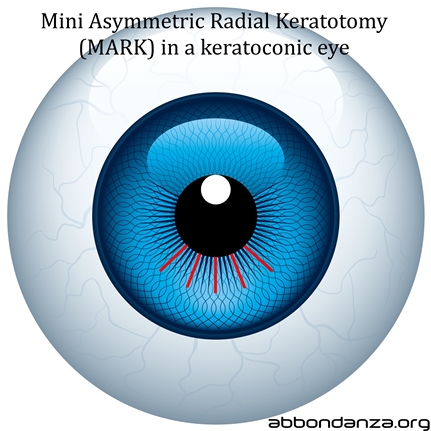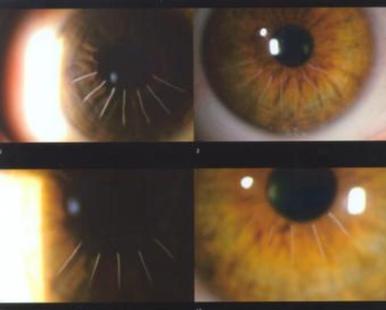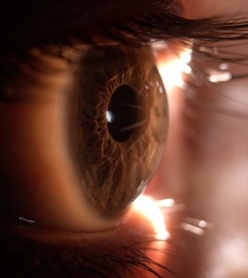MINI ASYMMETRIC RADIAL KERATOTOMY (MARK) FOR KERATOCONUS:
On the basis of his previous experiences with keratoconus surgery, which started in 1984, Dr. Marco Abbondanza devised a new surgical technique for keratoconus in 1993, called Mini Asymmetric Radial Keratotomy (MARK). MARK surgery is performed only in the area of the cornea where keratoconus is localized (“Asymmetric”) with tomography- and topography-guided micro-incisions (“Mini”).
 .
.
.

 Mini Asymmetric Radial Keratotomy (MARK) is performed with a diamond knife and a ‘double concentric corneal marker’, a surgical instrument devised by Dr. Abbondanza. MARK surgery flattens the cornea and reduces visual aberrations (astigmatism and/or myopia), that appear as a result of corneal deformation due to keratoconus. However, since MARK surgery is performed only in the area where keratoconus is localized, both the flattening and the structural reinforcement of scar tissue occur only locally in the distorted zone, while excessive flattening of the cornea is avoided.
Mini Asymmetric Radial Keratotomy (MARK) is performed with a diamond knife and a ‘double concentric corneal marker’, a surgical instrument devised by Dr. Abbondanza. MARK surgery flattens the cornea and reduces visual aberrations (astigmatism and/or myopia), that appear as a result of corneal deformation due to keratoconus. However, since MARK surgery is performed only in the area where keratoconus is localized, both the flattening and the structural reinforcement of scar tissue occur only locally in the distorted zone, while excessive flattening of the cornea is avoided.
The primary result of Mini Asymmetric Radial Keratotomy (MARK) is a significant improvement of vision. The second important result is the stopping or slowing of keratoconus progression.
Mini Asymmetric Radial Keratotomy’s first operations were performed in 1993 and routine check-ups have shown stabilization of the operated corneas. Today Mini Asymmetric Radial Keratotomy is a well-known technique and its validity is popularized by a number of centers in different countries (Italy, France, Germany, USA, Australia, New Zealand, Japan, India, United Arab Emirates, Qatar, South Africa, Hungary, China) and by several scientific publications and university theses.
Mini Asymmetric Radial Keratotomy (MARK) can be successfully combined with Corneal Collagen Cross-linking, a parasurgical technique introduced in Italy by Dr. Abbondanza in 2005, in order to achieve the best visual performance with the highest strengthening of the cornea. Dr. Marco Abbondanza has been the first to combine MARK surgery and Corneal Collagen Cross-linking for keratoconus. An important research, published in 2019, confirms the validity of the MARK + CXL combined intervention, as it is able to halt the progression of keratoconus while improving visual acuity. Such results were recorded and evaluated with long-term follow-up (click here to read the research). Another clinical study, published in 2016 by scientific journal Acta Medica International (click here to read it), showed that Dr. Abbondanza’s MARK+CXL combined protocol, knows as the “Rome Protocol”, produces an average reduction in corneal curvature of 3,7D and a significant decrease of corneal aberrations, along with the halting of the disease itself. Further, a clinical study published in 2018 confirms the excellent outcomes of MARK for early and progressive keratoconus (click here to read it).
SCIENTIFIC STUDIES CITING MINI ASYMMETRIC RADIAL KERATOTOMY (MARK):
• 1991 – N. M. Sergienko; N. Z. Solodkii; E. S. Golub, Radial asymmetric keratotomy in mild-degree myopia (Moscow: Vestnik Oftalmologii, 1991), 107 (5):34-36
• 1992 – Marco Abbondanza, Correzione chirurgica del cheratocono tramite Cheratotomia Radiale Asimmetrica – ARK (Rome: Rivista di Oftalmologia Sociale, 1992), 15 (2)
• 1992 – Fabio Dossi; Umberto Merlin, La Cheratotomia Radiale – Nozioni pratiche per il suo impiego (Milan: Fogliazza editore, 1992): 116
• 1995 – N. M. Sergienko; H. Hamard; N. Z. Solodkii; Y. M. Ruellan, Asymmetric Radial Keratotomy for low-grade myopia (Paris: Journal Français d’Ophtalmologie, 1995), 18 (1): 60-3
• 1997 – Marco Abbondanza, Asymmetric Radial Keratotomy for the Correction of Keratoconus (Thorofare: Journal of Refractive Surgery, 05/1997), 13 (3): 302-307
• 1997 – Marco Abbondanza, Mini Cheratotomia Radiale Asimmetrica (Mini ARK) per la correzione chirurgica del Cheratocono in fase iniziale, nell’ipermetropia e nelle miopie lievi (Rome: Esperienze, 1997), 12 (1)
• 1999 – Angelo Appiotti; Massimo Gualdi, Treatment of keratoconus with laser in situ keratomileusis, photorefractive keratectomy, and radial keratotomy (Thorofare: Journal of Refractive Surgery, 03-04/1999), 15 (2): 240-242
• 2007 – A new option for keratoconus: Intacs and Collagen Cross linkage (Dubai: Al-Zahra Hospital, 2007): 9
• 2008 – Amr Fathy Ahmed Elgarhy, Recent advances in treatment of Keratoconus (Beni-Suef: Beni-Suef University, 2008), 59-60, “Asymmetric Radial Keratotomy”
• 2008 – Reena Sharma; Namrata Sharma; Jeewan S. Titiyal, Keratoconus – Therapeutic Options (New Delhi: DOS Times, 07/2009), 14 (1): 33-37
• 2008 – 170. Versammlung des Vereins Rheinisch-Westfälischer Augenärzte in WUPPERTAL (Wuppertal: Verein Rheinisch-Westfälischer Augenärzte, 08-09 February 2008): 12
• 2009 – Marco Abbondanza; Barmak Abdolrahimzadeh; Mauro Zuppardo, Refractive Changes Following CXL (Wayne: Cataract & Refractive Surgery Today Europe, 2009), 04 (07): 33-38
• 2010 – Mattia Flores, Cheratocono (Rome: Agenda della Salute, Gennaio/Febbraio 2010): 66
• 2010 – Paola Marazziti, Cheratocono. Sintomi, diagnosi e cura (Rome: Medicina & Benessere, 2010)
• 2012 – Instruments for investigation and correction of the human eye disorders (Ternopil: Ternopil State Medical University, 2012), “Videokeratograph”
• 2013 – Refractive Eye Surgery (Kolkata: Susrut Eye Foundation & Research Centre, 2013), “Mini Asymmetric Radial Keratotomy (M.A.R.K.)”
• 2013 – Maura Peripoli, Il Cheratocono (Bergamo: Benessere, 2013)
• 2013 – Markus Kohlhaas, Keratoconus (Dortmund: St. Johannes Hospital Dortmund, 2013): 8-11
• 2013 – Lamis Abdelaziz; Ramez Barbara, History of the Development of the Treatment of Keratoconus (Haifa: International Journal of Keratoconus and Ectatic Corneal Diseases, January/April 2013), 2 (1): 31-33
• 2013 – Kamal Enam; Eman Azmy; Abd El-monem Abou El-Fetouh, Anatomical and functional changes in the cornea and retina after ultraviolet-A riboflavin cross-linking in patients with keratoconus (Cairo: Journal of the Egyptian Ophthalmological Society, 10/08/2013), 106 (3): 210-216
• 2014 – Dimitrios Karamichos; Jesper Hjortdal, Keratoconus: Tissue Engineering and Biomaterials (Basel: Journal of Functional Biomaterials, 2014), 5 (3): 111-134
• 2014 – T. Wang; Y. Peng; N. Shen; Y. Yu; M. Yao; J. Zhu, Photochemical activation increases the porcine corneal stiffness and resistance to collagenase digestion (San Francisco: Experimental Eye Research, 2014), 103 (Special Issue: Stem Cells): 97-104
• 2015 – I. Kocak, A. Aydin, F. Kaya, H. Baybora, S. Bozkurt, Efficacy of radial keratotomy in the optical rehabilitation of mild to moderate keratoconus cases. (Xi’an: International Eye Science, 2015), 15 (4): 572-576
• 2015 – M. P. Garcìa Félix, Cambios Refractivos y Morfologicos en Pacientes con Queratocono Sometidos a Crosslinking (Aguascalientes: Universidad Autònoma de Aguascalientes, 2015): 4
• 2015 – Marco Abbondanza, Margherita Guidobaldi, Corneal Collagen Cross-linking in a Prepubescent 10-Year-Old Girl with Aggressive Keratoconus (Haifa: International Journal of Keratoconus and Ectatic Corneal Diseases, 2015), 4 (2): 63-65
• 2015 – Juan Pedro Álvarez de Toledo Elizalde, Evoluciòn a Largo Plazo del Astigmatismo Tras Queratoplastia Penetrante en Queratocono: Evidencia de recurrencia tardìa (Barcelona: Universitat Autònoma de Barcellona, 2015): 82-83
• 2015 – Marco Abbondanza, Gabriele Abbondanza, Surgical Correction of an Inverse Astigmatic Keratotomy following Penetrating Keratoplasty in a Patient with Keratoconus (Haifa: International Journal of Keratoconus and Ectatic Corneal Diseases, 2015), 4 (3): 107-109
• 2016 – Marco Abbondanza, Barmak Abdolrahimzadeh, Margherita Guidobaldi, Combined Corneal Collagen Cross-linking and Mini Asymmetric Radial Keratotomy for the Treatment of Keratoconus (Moradabad: Acta Medica International, 2016), 3 (1): 63-68
• 2016 – Marco Abbondanza, Il cheratocono tra presente e futuro (Rome: 360 gradi in Oftalmologia, 2016), 2 (5): 5-8
• 2017 – Marco Abbondanza, Gabriele Abbondanza, Valentina De Felice, Mini Asymmetric Radial Keratotomy and Corneal Cross-linking for the Treatment of a Bilateral Stage IV Keratoconus in a 14-year-old Child (Sarajevo: Medical Archives, 2017), 71 (1): 69-71
• 2017 – K. Fujimoto, H. Osawa, T. Moriyama, T. Miyamoto, T. Irie, T. Nishimura, T. Inoue, Long-Term Stability of Minimally Invasive Radial Keratotomy for Mild to Moderate Keratoconus (Hong Kong: Asia-Pacific Journal of Ophthalmology, 2017), 6 (5): 407-411
• 2018 – Marco Abbondanza, Gabriele Abbondanza, Valentina De Felice, Long-term Results of Mini Asymmetric Radial Keratotomy for the Treatment of Keratoconus (Haifa: International Journal of Keratoconus and Ectatic Corneal Diseases, 2018), 7 (2): 105-109
• 2018 – O. Yu. Komarova, K. E. Lapshin, K. V. Burdel, A. V. Shatskikh, M. V. Zimina, A. N. Pashtaev, S. V. Novikov, S. K. Vartapetov, S. B. Izmailova, Innovative Technologies in Experimental Corneal Surgery Ex Vivo (Moscow: Современные технологии в медицине, 2018), 10 (4): 84-91
• 2018 – Sandeepani K. Subasinghe, Kelechi C. Ogbuehi, George J. Dias, Current perspectives on corneal collagen crosslinking (CXL) (Berlin: Graefe’s Archive for Clinical and Experimental Ophthalmology, 2018), 256 (8): 1363-1384
• 2019 – Marco Abbondanza, Gabriele Abbondanza, Valentina De Felice, Zoie Shui-Yee Wong, Long-term Results of Mini Asymmetric Radial Keratotomy and Corneal Cross-linking for the Treatment of Keratoconus (Seoul: Korean Journal of Ophthalmology, 2019), 33 (2): 189-195
• 2019 – J Wang, Z Li, H Zhang, N Gao, G Mu, Whether Keratectasia Area Shown in Corneal Topography Is Appropriate for Evaluating the Effect of Corneal Cross-Linking for Keratoconus: A 12-Month Follow-Up Study (London: BioMed Research International, 2019), https://doi.org/10.1155/2019/1762537, 1-5
• 2019 – Marco Abbondanza, Gabriele Abbondanza, Valentina De Felice, Mini Asymmetric Radial Keratotomy and Corneal Cross-linking for the Treatment and the Optical Rehabilitation of Keratoconus (Haifa: International Journal of Keratoconus and Ectatic Corneal Diseases, 2019), 8 (2): 35-39
• 2020 – Kim, Kyeong Hwan, and Mian, Shahzad I. “Refractive approaches to visual rehabilitation in patients with keratoconus”, Current Opinion in Ophthalmology, 31 (4): 261-267
• 2020 – Lanxing Fu; Bhupendra C. Patel, “Radial Keratotomy Correction”, StatPearls, PubMed: https://pubmed.ncbi.nlm.nih.gov/32644588
Dr. Abbondanza has been researching and treating keratoconus for over 30 years and especially considers Mini Asymmetric Radial Keratotomy (MARK), alone or combined with Corneal Collagen Cross-linking, as highly effective for obtaining the best possible optical correction and corneal stabilization.
.
